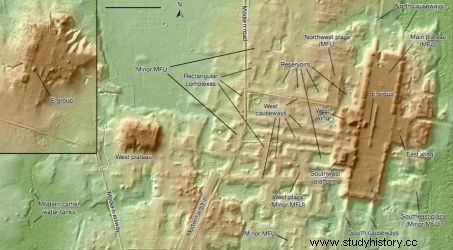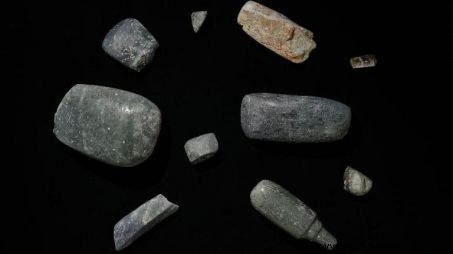3,000 years old, Aguada Fénix, the most monumental ceremonial complex of the entire Mayan civilization, was spotted for the first time in the state of Tabasco, Mexico. It would be the largest pre-Hispanic construction encountered to date in Central America.

Lidar image of the recently discovered site of Aguada Fénix in the state of Tabasco, Mexico.
Larger than the pyramid complex of La Danta (400 BC - 200 AD), arranged in a natural hill of the site of El Mirador (Guatemala); prior to Seibal (950 BC), considered until then as the oldest Mayan ceremonial center... Aguada Fénix breaks all records! This site, detected in the Mexican state of Tabasco, in the southwest of the Yucatan Peninsula, now appears to be the largest and oldest structure ever observed for this ancient civilization, according to the study published on June 3, 2020 in Nature magazine :an artificial platform oriented north-south 1400m long, 400m wide and about fifteen meters high, from which nine major roads would radiate.
This discovery, concomitant with that of 21 other less important sites, follows Lidar surveys (Light Detection and Ranging ). This method of airborne remote sensing uses laser pulses coupled with high precision GPS to detect structures on the ground, including those under the canopy. Revolutionary, it makes it possible to generate 3D digital maps and its use, in recent years has upset the study of the Mayan world by revealing countless totally unknown sites. This is what happened for Takeshi Inomata, an archaeologist from the University of Tucson (Arizona) with the discovery of this gigantic structure that until then had been undetectable on the ground.

High resolution lidar images of the Aguada Fénix complex in the surrounding context. ©Takeshi Inomata / University of Arizona /Nature
The oldest Mayan ceremonial complex
Aguada Fenix would thus have been erected around 1000 BC, a period that the "Mayanists" - specialists in the Maya world - describe as "Middle Preclassic" (1000-350 BC). Either before the peak period of this so-called "classical" civilization (between 250 and 900). Even more than the famous pyramid sites built in stone and rising vertically - such as Tikal (Guatemala) or Palenque (Mexico) 1500 years later - "the earth and clay structure of Aguada Fénix constitutes a flat -form that required significant community mobilization to amass millions of cubic meters of earth and clay (between 3.2m 3 and 4.3m 3 ) ", explains Takeshi Inomata, the lead author of the study.
Specialists have seen in this architectural horizontality a possible Olmec influence, named after this first great culture that reigned over the Gulf of Mexico in the 13 e on the 4 th century before our era (read Science and Future of June 2020 ). Similar platforms have indeed been exhumed in the past on the site of Sao Lorenzo (1400-1150 BC) in the neighboring state of Veracruz, 400 km to the west. Aguada Fénix could thus have emerged after the decline of this first Olmec capital, before the appearance of its other great center located at La Venta. An analysis that does not share the American archaeologist Ann Cyphers, of the Institute of Anthropological Research of the National Autonomous University of Mexico (Unam), reference for the Olmec society. "From an architectural point of view, the two sites of Aguada Fénix and San Lorenzo looks very distinct to me , she says, joined by Sciences et Avenir. Today, Aguada Fénix seems to me to have more affinities with sites in the Maya lowlands or central Chiapas, rather than with the Olmec San Lorenzo".

Stone statuette representing a peccary pig (1000 years BC). ©Takeshi Inomata / University of Arizona /Nature
A monumental structure that has yielded few remains
For the time being, archaeological excavations have not yielded any large sculptures, unlike the colossal ones that had been extracted from San Lorenzo. Only a small statuette, probably representing a peccary pig, was found as well as a series of pottery and axes made of jadeite and obsidian, a volcanic rock very popular with the Mayas.

Some jadeite axes from the excavations at Aguada Fénix. ©Takeshi Inomata / University of Arizona /Nature
"Was this ceremonial site intended for mass rituals? Could crowds have gathered here in huge processions" , ask the researchers at the University of Arizona. Maybe during calendar events? Speculations supported by the presence in the center of the platform of a building known in the Mayan universe under the enigmatic name of "Group E". A type of structure unique to this civilization, linked to the solar calendar and ceremonial concerns. Anyway, the gigantic platform seems to have functioned barely 200 years before being abandoned along with several neighboring sites around 800-750 BC.
